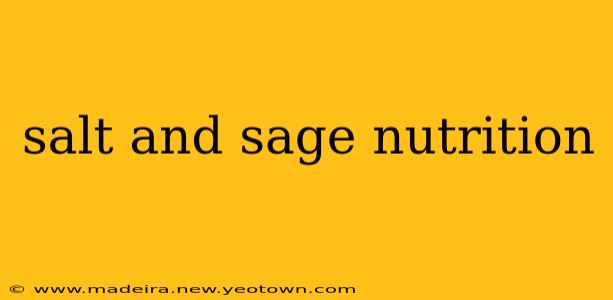Salt and sage. Two seemingly simple ingredients, yet they form the backbone of countless savory dishes, adding depth, complexity, and a touch of rustic charm. But beyond their culinary prowess, both salt and sage offer unique nutritional benefits that often go unnoticed. Let's delve into the world of these culinary powerhouses and uncover their surprising health advantages.
What are the Nutritional Benefits of Salt?
Now, before you reach for the salt shaker with reckless abandon, let's clarify. We're not advocating for excessive salt consumption. High sodium intake is undeniably linked to various health problems, including high blood pressure. However, moderate amounts of unprocessed salt, specifically sea salt or Himalayan pink salt, can contribute to overall well-being in several ways.
Essential Minerals: Salt, primarily sodium chloride, provides essential minerals like sodium and chloride, vital for maintaining proper fluid balance, nerve function, and muscle contractions. Sodium plays a critical role in transmitting nerve impulses, while chloride is essential for stomach acid production.
Electrolyte Balance: Salt helps maintain the body's electrolyte balance, crucial for hydration and preventing muscle cramps. This is particularly important for athletes and individuals who sweat profusely.
What are the Nutritional Benefits of Sage?
Sage, a fragrant herb belonging to the mint family, boasts an impressive nutritional profile, offering a variety of vitamins, minerals, and antioxidants.
Antioxidant Powerhouse: Sage is rich in antioxidants, primarily rosmarinic acid, which helps protect cells from damage caused by free radicals. Free radicals contribute to aging and the development of chronic diseases.
Cognitive Benefits: Some studies suggest that sage may enhance cognitive function and memory, particularly in individuals with mild cognitive impairment. More research is needed in this area, but the preliminary findings are promising.
Anti-inflammatory Properties: Sage possesses anti-inflammatory properties, potentially beneficial for reducing inflammation throughout the body. This can be particularly helpful for individuals with inflammatory conditions such as arthritis.
Is Sage High in Sodium?
This is a question many people ask. Sage itself is not a significant source of sodium. The sodium content in your dish primarily comes from the added salt. Therefore, choosing to season your sage-infused dishes with a moderate amount of unprocessed salt is key to reaping its benefits without compromising your health.
What are the Health Benefits of Salt and Sage Together?
When used together, salt and sage create a flavor synergy that elevates culinary creations. The subtle salty notes enhance the earthy, slightly peppery flavor of the sage, leading to a balanced and flavorful experience. The nutritional benefits are largely additive – the minerals from the salt and the antioxidants and potential cognitive benefits from the sage.
How Much Salt and Sage Should I Consume?
The recommended daily sodium intake is generally less than 2,300 milligrams, with even lower amounts recommended for certain individuals. The amount of sage you consume depends on personal preference and culinary needs. Using it sparingly can enhance the flavor of dishes without overwhelming the palate.
Conclusion: A Balanced Approach
Both salt and sage, when consumed in moderation, can contribute to a healthy diet. The key is balance and mindful consumption. Prioritize unprocessed salt and enjoy the culinary magic (and potential health benefits) that salt and sage bring to your table. Remember to consult with a healthcare professional or registered dietitian for personalized advice on dietary choices, especially regarding sodium intake.

